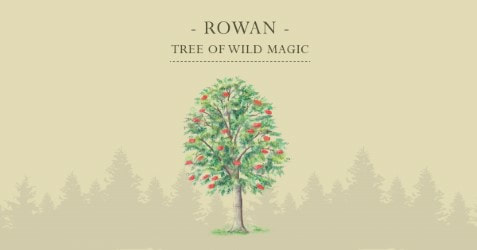Rowan- Tree of wild magicA bird flies over a steep mountainside and drops a Rowan seed that lands in a rock crevice which sprouts and gives life to a tree with creamy white clusters of flowers and bright red berries. Aptly named mountain ash the rowan is the tree that grows higher up a mountainside than any other native tree. It is not related to ash but shares the same feather-like leaves created by numerous leaflets on the same stalk. Various insects feed on its flowers and song birds including thrushes, redwings and fieldfares flock to feast on its berries. The Rowan truly is a delight of the eye and a tree worth exploring. The native Rowan is a tree of the wild uninhabited cold places of Britain. It grows on the windswept cliffs of the river Wye and Scotland producing scarlet red berries which birds gorge upon, and beautiful white flowers which insects feed from. In old stories it is guarded by giants and offers a bridge to the land of promise and eternal youth to one who dares approach it. For the Rowan stands as a threshold guardian, afeared by those with a tainted heart, the paramount tree of the Druids, Witches and Magicians, a protector of the green world whose use can bring joy or sorrow depending on who implements its magic! The Sorbus family to which rowan belongs is both fascinating and beautiful just like its stories of magic. You can see how it stands as a guardian, almost like a beacon of hope out on those unforgiving landscapes offering flower, fruit and shelter where there is little on offer. A very different species from the cultivated tree often seen in parks, roundabouts or roadsides. Its family include Britain’s rarest tree, the True Service Tree or Whitty Pear ( S.domestica) and the Wild Service (S.torminalis) which has more maple-like leaves and small pear-like fruits. In addition to these species there are up to 18 rare or endemic species of Whitebeam (S.aria) specific to a range of places from Devon to the Wye valley and the Isle of Arran to Wales and Ireland. Folklore of Rowan/ Mountain Ash Delight of the eye is Mountain Ash, owing to the beauty of its berries. Delight of the eye. Strength or friend of cattle, the Elm. Strength of cattle. Book of Ballymote 1391 Rowan is a natural progression from the study of Birch, both dominating trees in Scotland and both abundantly praised by the poets. The inclusion of Elm in the above kenning is explored over the page. Oisin, old and blind, and compelled to fast, asked a swine-herd , to guide him to a certain rowan tree, that he may feast on its berries. Irish texts society translation David Nutt 1908 A common theme explored in Celtic folklore is retiring to the woods at a certain stage in life. This seems to be a universal theme as Hindus recognise in their old age a period of time also to retire to the Forest which is representive of a time to contemplate and enjoy the fruits of the inner worlds now the body is ageing. Maybe this is why in the stories Rowan berries bestow youth to old age. Old age can be celebrated as a re-birth into the realms of the inner landscape, the soul or Tir na nOg, the land of youth. Traditionally this knowledge of the soul is guarded well and to continue with the story of Diarmaid and Grainne (mentioned in the Birch booklet) the tree of Dubhros that they encounter is guarded by Searbhan Lochlannach, a baleful giant who can only be killed by his own club! This theme of protection continues in the story of the Faery Rowan- tree: ‘No mortal may take a berry that grows on it... Fergus will have to guard this tree until he gets one who will guard it for him’ Interestingly enough it is a giant, Crom Duv, whom Fergus finds to continue the guardianship. He has a herd of goats and while guarding the tree obtains a herd of cattle. When Crom Duv takes his cattle to new pastures the faery Rowan is guarded by the Bull of the Mound and twenty- four fierce yellow cats! These common themes link us back to the opening kennings of this section which may be the essence of the tree in Celtic folklore. The kennings connect us to its beauty, and the use of the word ‘eye’ probably is referring to an inner beauty or inner gaze. The kennings also connect us to the land through their mention of cattle. Cattle were a status symbol, a currency as well as a symbol of the fecundity of the land. Beef would have been a luxurious meat for feasts as the herd were of such value both for milk and blood. Farming was a key to a more stable, richer way of life as each person knew their dependency upon it, creating a sacredness of farm animals. It is the swineherd that guides the great hero Oisin in his old age, the bull that protects the tree and the cattle and pigs which are featured in so many Celtic stories. Today domestic livestock still have a positive effect on the land maintaining old meadows, moors and downs as well as providing meat. This relationship between people, the land and animals was paramount to our ancestors. This means that the Rowan in folklore has a key status in the health and well-being of the land. This is further enhanced in the ritual of Tarbh Feis, which is sometimes used to divine the future King. The seer/poet spends the night on a platform made of rowan wrapped in a bull skin. Again this connection of the Rowan and cattle. The Elm is also mentioned in the kennings and it is a tree that would have been used for fodder, providing food for cattle. The Elm’s presence in the landscape can be seen in paintings like the Hay Wain by Constable, or in Brighton, East Sussex where its majesty continues in the living landscape shining like a guardian of the countryside. The third element coming into play is the King who played a key role as a caretaker of the ancient land, for a good reign would bring good health to crops and animals. The giants guarding the tree represent the oldest inhabitants of the land, the raw energy of the green world and its protection above all else; a world where we protect the wealth of the land passionately, where our heroes look to the farmers, crops and animals with loyal passion; where our kings wish to adhere to Nature’s laws above all else and show respect to the wise female elders; and where the sacred trees are honoured as guardians. This is the message of Rowan and is needed now more than ever! The Uses of Rowan This tree is a delight to those who have a love of nature and magic, and its wood and berries are considered to be protective and lucky charms. Rowan wood has a yellow tinge and is strong and flexible. Traditionally it was used to make tool handles and for smaller carved items. It is possible that like Whitebeam it was also used to make bows. Medicinally rowan bark is used for treating diarrhoea and its berries for sore throats. If you have enjoyed this article you may wish to sign up for our free newsletter packed with information on Trees, plants and connecting with nature. If you would like to explore Nature Connection and receive our free Newsletter packed with articles on Trees and plants please click below.
1 Comment
Arilyn Buchannon
7/24/2019 07:54:59 pm
I completely enjoyed this article thank you!!
Reply
Leave a Reply. |
Details
Poetry of flowersJoin me to explore the flora of the British Isles on this blog. My intention is to attempt to capture the unique quality and beauty of each species of flower, tree or shrub. For every species featured I will be growing many more wildflowers to celebrate the joy of their existence, their intrinsic conservation value and bewildering array of uses. For nearly 30 years I have noted, studied and explored wildflowers in the field much to the patience of the walker beside me. To share this passion is a heartfelt plea to respect, preserve and care for all British Wildflowers no matter how common they seem. Archives
February 2024
Categories |


 RSS Feed
RSS Feed
